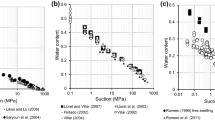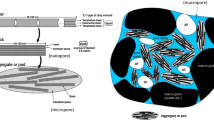Abstract
An effective thermal conductivity model was proposed for unsaturated compacted bentonites with consideration of the bimodal shape of pore size distribution curves. The pores of soils were grouped into two dominant pore size modes corresponding to the intra- and inter-particle pores, and were simulated with randomly distributed spheroidal inclusions of different aspect ratios. With the assumption of preferential invasion of the wetting fluid (water) into pores of smaller sizes and by virtue of the analytical solution to the inhomogeneous inclusion problem in heat conduction, the model was developed using the Mori-Tanaka (MT), Ponte Castañeda-Willis (PCW) and self-consistent (SC) homogenization approaches for different considerations of the interactions between pores and the solid phase. The proposed model is functions of the thermal conductivities of the solid, liquid and gas phases, porosity, the degree of saturation, the aspect ratios of pores and/or soil particles, and the fraction of the smaller group of pores. The proposed model was validated against five sets of laboratory measurement data on the MX-80, FEBEX, Kunigel-V1 and GMZ01 bentonites, showing a good agreement between the model predictions and the laboratory measurements. The responses of the model with respect to the geometries of pores and solid particles were examined. Compared to series-parallel structural models, the proposed model may overall exhibit better performance if proper homogenization schemes are adopted, but as an advantage, the model has clearer physical mechanisms and a smaller number of parameters.
Similar content being viewed by others
References
Tong F, Jing L, Zimmerman R W. An effective thermal conductivity model of geological porous media for coupled thermo-hydro-mechanical systems with multiphase flow. Int J Rock Mech Min Sci, 2009, 46: 1358–1369
Chen Y, Zhou S, Hu R, et al. Estimating effective thermal conductivity of unsaturated bentonites with consideration of coupled thermo-hydro-mechanical effects. Int J Heat Mass Transfer, 2014, 72: 656–667
Chen Y, Zhou C, Jing L. Modeling coupled THM processes of geological porous media with multiphase flow: Theory and validation against laboratory and field scale experiments. Comput Geotech, 2009, 36: 1308–1329
Rutqvist J, Zheng L, Chen F, et al. Modeling of coupled thermohydro-mechanical processes with links to geochemistry associated with bentonite-backfilled repository tunnels in clay formations. Rock Mech Rock Eng, 2014, 47: 167–186
Kahr G, Müller-Vonmoos M. Wärmeleitfähigkeit von Bentonit MX80 und von Montigel nach der Heizdrahtmethode. Schweiz: Nagra, 1982. NTB 82-06
Knutsson S. On the thermal conductivity and thermal diffusivity of highly compacted bentonite. Swedish Nuclear Fuel and Waste Management Co.. Stockholm: SKB, 1983. 83–72
Madsen F T. Clay mineralogical investigations related to nuclear waste disposal. Clay Miner, 1998, 33: 109–129
Villar M V. Caracterización termo-hidro-mecánica de una bentonita de Cabo de Gata. Dissertation of Doctoral Degree. Madrid: Universidad Complutense de Madrid. 2000, 396
Ould-Lahoucine C, Sakashita H, Kumada T. Measurement of thermal conductivity of buffer materials and evaluation of existing correlations predicting it. Nucl Eng Des, 2002, 216: 1–11
Lloret A, Romero E, Villar M V. FEBEX II Project Final report on thermo-hydro-mechanical laboratory tests. Empresa Nacional de Residuos Radiactivos. Madrid: Publicación técnica. 2004, 10: 11–165
Lloret A, Villar M V. Advances on the knowledge of the thermohydro-mechanical behaviour of heavily compacted “FEBEX” bentonite. Phys Chem Earth, Parts A/B/C, 2007, 32: 701–715
Liu Y, Cai M, Wang J. Thermal properties of buffer material for high-level radioactive waste disposal. Chin J Rock Mech Eng, 2007, 26: 3891–3896
Tang A M, Cui Y J, Le T T. A study on the thermal conductivity of compacted bentonites. Appl Clay Sci, 2008, 41: 181–189
Ye W M, Chen Y G, Chen B, et al. Advances on the knowledge of the buffer/backfill properties of heavily-compacted GMZ bentonite. Eng Geol, 2010, 116: 12–20
Yong R N. Overview of modeling of clay microstructure and interactions for prediction of waste isolation barrier performance. Eng Geol, 1999, 54: 83–91
Ye W M, Wang Q, Pan H, et al. Thermal conductivity of compacted GMZ01 bentonite (in Chinese). Chin J Geotech Eng, 2010, 32: 821–826
Ye W M, Qian L X, Chen B, et al. Characteristics of Micro-structure of densely compacted Gaomiaozi bentonite (in Chinese). J Tongji Univ (Nat Sci), 2009, 37: 31–35
Holzer L, Münch B, Rizzi M, et al. 3D-microstructure analysis of hydrated bentonite with cryo-stabilized pore water. Appl Clay Sci, 2010, 47: 330–342
Tomioka S, Kozaki T, Takamatsu H, et al. Analysis of microstructural images of dry and water-saturated compacted bentonite samples observed with X-ray micro CT. Appl Clay Sci, 2010, 47: 65–71
Saba S, Delage P, Lenoir N, et al. Further insight into the microstructure of compacted bentonite-sand mixture. Eng Geol, 2014, 168: 141–148
Ichikawa Y, Kawamura K, Fujii N, et al. Microstructure and micro/macro-diffusion behavior of tritium in bentonite. Appl Clay Sci, 2004, 26: 75–90
Jiang P, Xiang H, Xu R. Theoretical and experimental study of the thermal conductivity of nanoporous media. Sci China Tech Sci, 2012, 55: 2140–2147
Johansen O. Thermal conductivity of soils. Dissertation of Masteral Degree. Norway: University of Trondheim. 1975, 236
Ewen J, Thomas H R. The thermal probe-a new method and its use on an unsaturated sand. Géotechnique, 1987, 37: 91–105
Sakashita H, Kumada T. Heat transfer model for predicting thermal conductivity of highly compacted bentonite. J At Energy Soc Jpn, 1998, 40: 235–240
Côté J, Konrad J M. A generalized thermal conductivity model for soils and construction materials. Can Geotech J, 2005, 42: 443–458
Cheng P, Hsu C T. The effective stagnant thermal conductivity of porous media with periodic structures. J Porous Media, 1999, 2: 19–38
Wang J, Carson J K, North M F, et al. A new structural model of effective thermal conductivity for heterogeneous materials with co-continuous phases. Int J Heat Mass Transfer, 2008, 51: 2389–2397
Tarnawski V R, Leong W H. A series-parallel model for estimating the thermal conductivity of unsaturated soils. Int J Thermophys, 2012, 33: 1191–1218
Gong L, Wang Y, Cheng X, et al. A novel effective medium theory for modelling the thermal conductivity of porous materials. Int J Heat Mass Transfer, 2014, 68: 295–298
Fricke H. A mathematical treatment of the electric conductivity and capacity of disperse systems I. The electric conductivity of a suspension of homogeneous spheroids. Phys Rev, 1924, 24: 575
Brailsford A D, Major K G. Thermal conductivity of aggregates of several phases, including porous materials. Br J Appl Phys, 1964, 15: 313
Zimmerman R W. Thermal conductivity of fluid-saturated rocks. J Pet Sci Eng, 1989, 3: 219–227
Shafiro B, Kachanov M. Anisotropic effective conductivity of materials with non-randomly oriented inclusions of diverse ellipsoidal shapes. J Appl Phys, 2000, 87: 8561–8569
Sevostianov I. Thermal conductivity of a material containing cracks of arbitrary shape. Int J Eng Sci, 2006, 44: 513–528
Gruescu C, Giraud A, Homand F, et al. Effective thermal conductivity of partially saturated porous rocks. Int J Solids Struct, 2007, 44: 811–833
Giraud A, Gruescu C, Do D P, et al. Effective thermal conductivity of transversely isotropic media with arbitrary oriented ellipsoidal inhomogeneities. Int J Solids Struct, 2007, 44: 2627–2647
Bary B. Estimation of poromechanical and thermal conductivity properties of unsaturated isotropically microcracked cement pastes. Int J Numer Anal Meth Geomech, 2011, 35: 1560–1586
Chen Y, Li D, Jiang Q, et al. Micromechanical analysis of anisotropic damage and its influence on effective thermal conductivity in brittle rocks. Int J Rock Mech Min Sci, 2012, 50: 102–116
Hashin Z. Assessment of the self consistent scheme approximation: conductivity of particulate composites. J Compos Mater, 1968, 2: 284–300
Lee Y M, Yang R B, Gau S S. A generalized self-consistent method for calculation of effective thermal conductivity of composites with interfacial contact conductance. Int Comm Heat Mass Transfer, 2006, 33: 142–150
Mori T, Tanaka K. Averages stress in matrix and average elastic energy of materials with misfitting inclusions. Acta Metall, 1973, 21: 571–574
Hashin Z. The differential scheme and its application to cracked materials. J Mech Phys Solids, 1988, 36: 719–734
Castañeda P P, Willis J R. The effect of spatial distribution on the behavior of composite materials and cracked media. J Mech Phys Solids, 1995, 43: 1919–1951
Zheng Q S, Du D X. An explicit and universally applicable estimate for the effective properties of multiphase composite which accounts for inclusion distribution. J Mech Phys Solids, 2001, 49: 2765–2788
Chen Y F, Zhou S, Hu R, et al. A homogenization-based model for estimating effective thermal conductivity of unsaturated compacted bentonites. Int J Heat Mass Transfer, 2015, doi: 10.1016/j.ijheatmasstransfer.2014.12.053
Zhou C, Li K, Pang X. Effect of crack density and connectivity on the permeability of microcracked solids. Mech Mater, 2011, 43: 969–978
Carson J K, Sekhon J P. Simple determination of the thermal conductivity of the solid phase of particulate materials. Int Comm Heat Mass Transfer, 2010, 37: 1226–1229
Author information
Authors and Affiliations
Corresponding author
Rights and permissions
About this article
Cite this article
Chen, Y., Wang, M., Zhou, S. et al. An effective thermal conductivity model for unsaturated compacted bentonites with consideration of bimodal shape of pore size distribution. Sci. China Technol. Sci. 58, 369–380 (2015). https://doi.org/10.1007/s11431-014-5738-3
Received:
Accepted:
Published:
Issue Date:
DOI: https://doi.org/10.1007/s11431-014-5738-3




